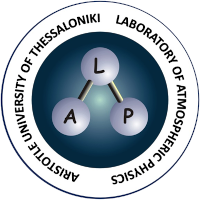Activities
| The world’s first commercially available Brewer MKII spectrophotometer was installed at the Laboratory of Atmospheric Physics (LAP) in 1982 for the systematic monitoring of the ozone layer. It was subsequently modified to provide additional measurements of the spectrum of direct and global ultraviolet (UV) solar radiation. In 1993, a Brewer MKIII double spectrophotometer was also installed with the main objective of performing more accurate measurements of the solar UV radiation spectrum in the region of 290-365 nm. Both instruments are part of established and global monitoring networks of the ozone layer and UV solar radiation (WOUDC, EUBREWNET) providing two of the longest time series on a global scale.
In 1994, the first active Light Detection And Ranging (LIDAR) remote sensing system was developed in LAP, in order to monitor the vertical distribution of particulate matter (PM) and tropospheric ozone. Since 2001, the THELISYS LIDAR device in LAP has been included in the EARLINET network and after its upgrade, it has become a part of the National Infrastructure of the corresponding European Network ACTRIS. Μeasurements of the optical and microphysical properties of PMs have been also performed by the CIMEL solar photometer since 2003 as a part of the international AERONET network. The synergy of the LIDAR and sun photometer measurements enabled the extensive study and characterization of the aerosols and the development of evolved algorithms for the standardization and the study of their composition. Moreover, long-term measurements allow the assessment of the climatology and the temporal variability of aerosols. Recently, in the framework of the collaboration between AUTH and the Karlsruhe Institute of Technology (KIT-IMK), LAP, has become a member of the COllaborative Carbon Column Observing network (COCCON) and hosts a Fourier Transform Infrared Spectroscopy (FTIR) spectrometer for measuring the total column of some of the main greenhouse gases (XCO2,XCO,XCH4,XH2O). The development of the Phaethon MAX-DOAS system began at LAP in 2006, for the purpose of measuring the tropospheric, stratospheric and total column gaseous components and pollutants, such as NO2, formaldehyde and ozone, as well as the optical thickness of aerosols. Three systems were built since 2014 and have been in continuous operation at LAP and KEDEK of AUTH, joining the global network NDACC (Network for the Detection of Atmospheric and Climate Change). In 2022, two new MAX-DOAS systems started to operate with improved standards in terms of their quality characteristics and measurement accuracy. The measurements performed by these systems are analyzed with a specific software to determine the vertical distribution of the atmospheric components in the first 2-4 km of the troposphere. The instruments described above, have been used/upgraded in the framework of several European and national research programs and have participated in several major international experimental campaigns. The measurements performed by these instruments have been used in numerous published scientific papers, as well as in theses of undergraduate and postgraduate students in the School of Physics in AUTH. |
| The Satellite Remote Sensing Group of the Laboratory of Atmospheric Physics (LAP) of AUTH focuses on the analysis, validation and exploitation of space-born observations of atmospheric species. The team members have wide-ranging experience and long-standing place in the atmospheric science community through their multi-decadal involvement in the validation of space-based geophysical parameters. The group has been involved since 1997 in the development of EUMETSAT’s O3MSAF (1997-2017) and subsequent ACSAF (2017-2022) projects and their validation activities, which comprise a variety of products and sensors, such as GOME/ERS2, GOME2 and IASI onboard MetopA, MetopB and MetopC. The LAP Satellite Remote Sensing Group has been a key player in major international satellite observation, algorithm development and validation activities such as the European Space Agency Ozone Climate Change Initiative (Ozone CCI), the EU FP7 Quality Assurance for Essential Climate Variables, the ESA Validation of total ozone from S5P TROPOMI on the global scale using Brewer, Dobson and UV-visible/SAOZ networks project as well as the S5P/Tropomi Mission Performance Centre (MPC) through its dedicated validation facility.
The team operationally hosts the World Ozone Mapping Center of the World Meteorological Organization (WMO) for the Northern Hemisphere and receives daily in near-to-real time preliminary total ozone data from around 100 ground based total ozone observing stations. LAP/AUTH also hosts and maintains an open-access validation site for EUMETSAT ACSAF satellite total ozone and ozone profile products. Finally, the Satellite Remote Sensing group of LAP/AUTH has been the coordinating and cooperating institute for more than 50 EC and national funded projects during its lifetime. |


